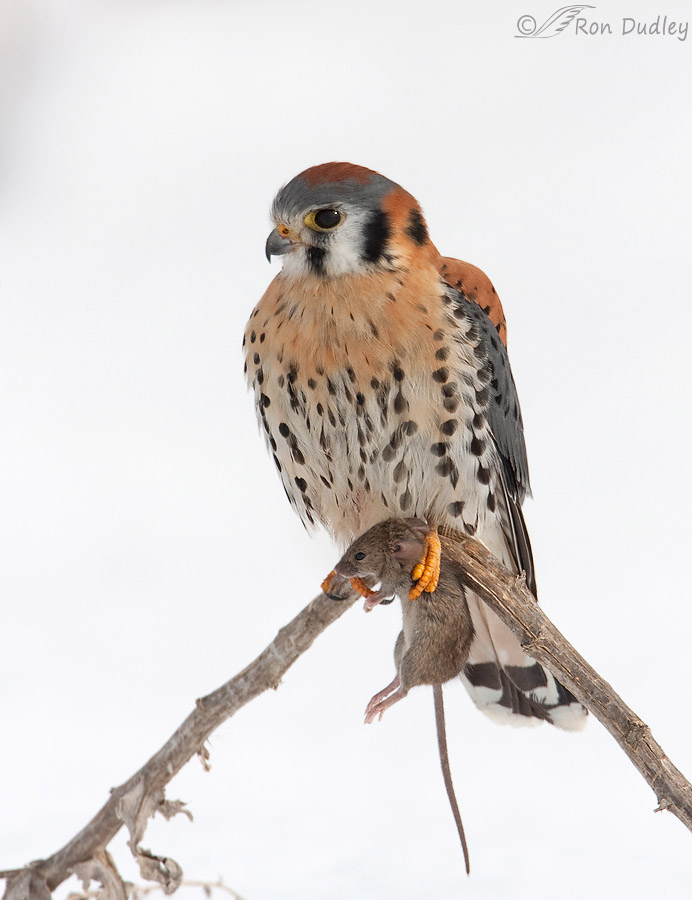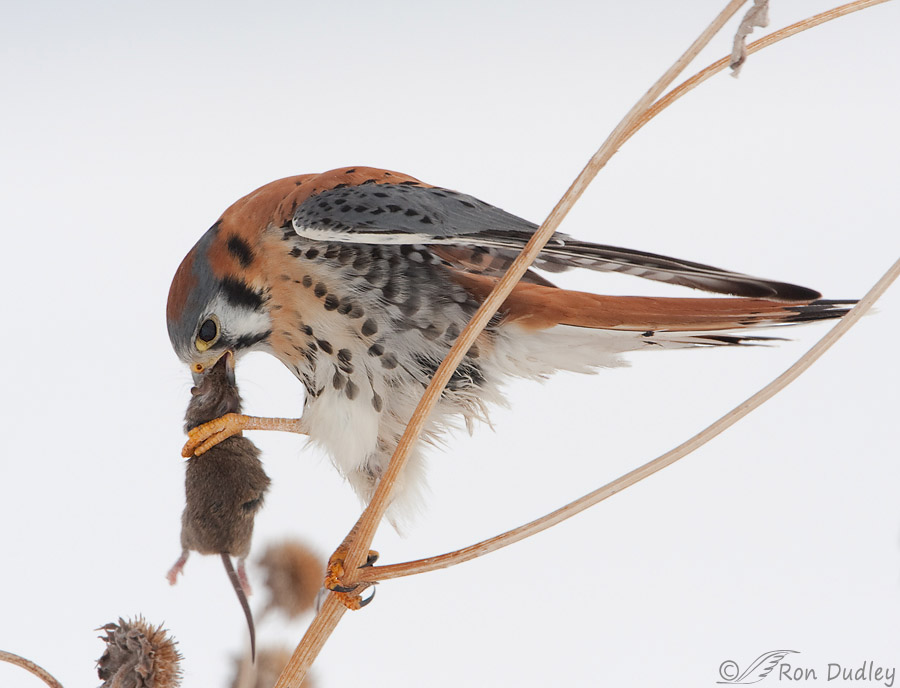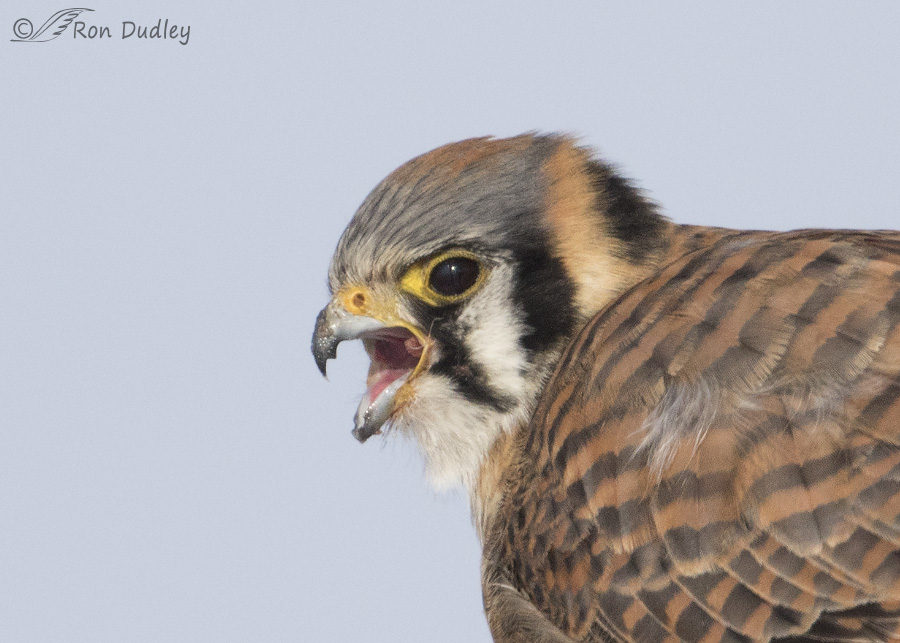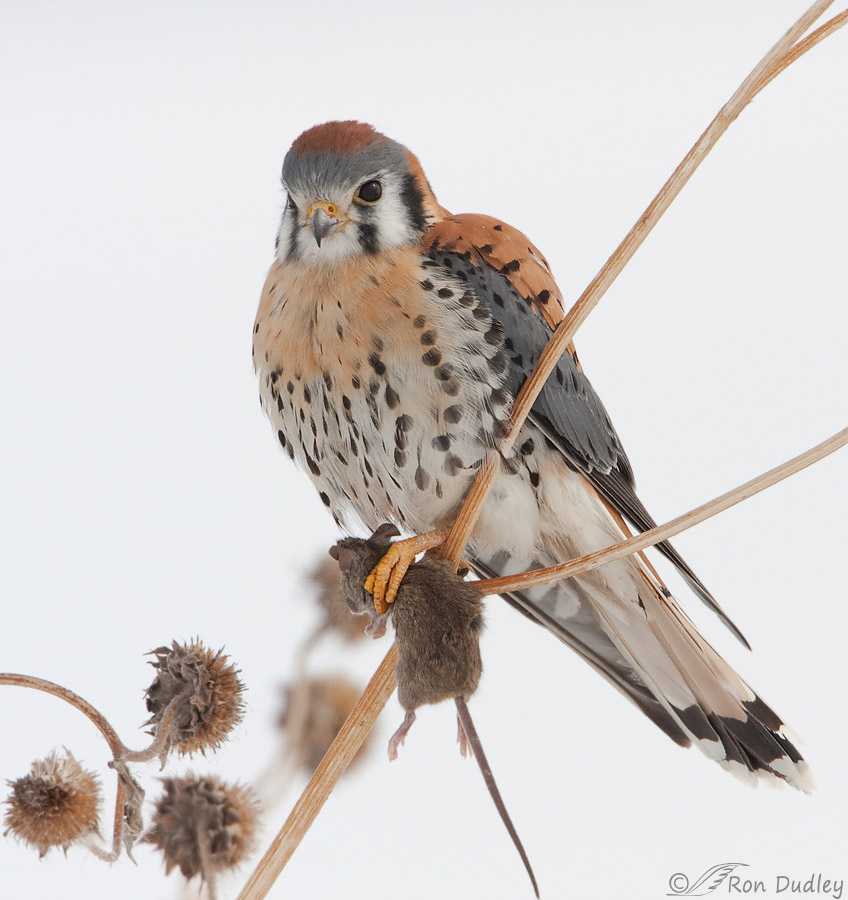Occasionally I rerun an older favorite post because very few current blog followers have ever seen it and since I’m now recovering from surgery this seemed like an appropriate time to do it again. The original version of this post was published on November 23, 2010. For this version I’ve added a photo, rewritten much of the text, cleaned up the formatting, updated my copyright watermark and changed my title.
Voles are by far the most common prey item I see American Kestrels with but occasionally I find them with a mouse or a small bird. This time, on a cold and snowy morning at Farmington Bay WMA, it was a mouse and it was still very much alive.

It was obvious that the mouse was still with us because it was struggling slightly, its tail was twitching and its eyes were open.
In my experience these birds often prefer a more stable perch than this rotting sunflower stalk while they consume their meal – something like a fencepost or pole that provides some kind of platform from which to eat. So I thought he might not consume the mouse here and I was right. He gave me time for a few quick shots and then flew off to another perch.
But he didn’t go far so I was able to photograph from up close again.
This next perch was also unstable to eat from because the wind was blowing moderately and both perch and bird were swaying in the breeze. By this time the mouse was recovering somewhat and its struggling increased but the stranglehold the little falcon had around its neck was very effective in preventing its escape.
But the kestrel was obviously uncomfortable with the struggling of the mouse so it was past time to put the little rodent out of its misery.

He dispatched the mouse quickly with several rapid bites to the head and neck so it quit struggling and obviously expired within seconds.
 This photo of a female kestrel gives us a closer look at the primary killing tool used by members of genus Falco – the maxillary tomia or “teeth” they use for severing the cervical spine of vertebrate prey.
This photo of a female kestrel gives us a closer look at the primary killing tool used by members of genus Falco – the maxillary tomia or “teeth” they use for severing the cervical spine of vertebrate prey.
The tomial tooth is a triangular-shaped, downward pointing sharp projection on the upper bill that fits nicely into a corresponding notch on the lower bill. The purpose of the falcon tooth isn’t necessarily to kill quickly (although if that happens it’s always convenient for the bird) but instead to damage the central nervous system, disable the prey and minimize the chances of escape.
Almost immediately after killing the mouse the male kestrel flew off with it – presumably to find a more suitable perch to use as a dinner table.
Ron



Sensational series Ron! SPEEDY RECOVERY!
charlotte
Beautiful photos, thanks for re-posting. Life ain’t easy!
You nailed its again. Beautiful shots and very educational! Thanks. Hope your lower back is improving eaves morale!! Linda
Thank you, Linda.
Once again, feeling very sorry for the prey…can’t help it…glad the beautiful little assassin found lunch, but still….. . Glad you’re doing OK. LOVE seeing “old” stuff(not so old that evolution has left its mark!!!
. Glad you’re doing OK. LOVE seeing “old” stuff(not so old that evolution has left its mark!!! )…our bird count has been WAY down this year…scary!!! So glad that day by day you’ll be feeling better, NOT WORSE!!!
)…our bird count has been WAY down this year…scary!!! So glad that day by day you’ll be feeling better, NOT WORSE!!!
I’m hearing far too many reports of reduced numbers of birds, Patty. So very discouraging…
Reading through the post and comments I am thrilled that your surgery has dispatched the pain, hopefully as well and as permanently as the mouse.
Fingers are crossed, EC. I hope so.
Magnificent detailed portraits of the kestrel. This winter tTey have not appeared in our local south Florida wetlands patch. We usually have three males occupying fairly distinct foraging territories. this has been a very odd winter with very few wintering warblers as compared to all the past winters since I moved here in 2004. Even the red-winged Blackbirds have been scarce. BTW, our kestrels seemed to eat mostly insects, especially dragonflies and grasshoppers. I think small mammals are rather rare in the wild areas here.
Some of what you say is worrisome, Ken – especially about your lack of wintering birds.
Kestrels eat insects here too, particularly grasshoppers in summer. Thank you.
Love the pop of the colorful Kestrel against that stark, snowy background. The first shot looks like two buddies just hanging out together, although I know better (poor little Mortimer!). I think that’s because of their common gazing direction. I also especially like the composition of the second shot. The spent flowers off to the side are the sprinkles on the sundae.
Hope you can get some rest today — perhaps a nap or three is in your future.
Thanks, Marty. I napped most of the day yesterday, probably too much.
Really stunning images, Ron. What a beauty; what a beast. Best image of the tomial tooth I have seen. Very elucidating.
Thanks, Lyle. I think I probably have better photos of the tooth in other falcons but this may be the best one I have belonging to a kestrel.
Lovely lovely photos. The tomial notch or tooth is also the killing tool of the Peregrine. I had an education Peregrine for 8 years. He’d been wing-shot. I fed him commercially raised quail, whole (and already dead, of course). He severed the spine of every one, right where it connects with the skull. I had a chance to look closely at some of these, and his “tooth” had gone cleanly between the vertebrae. Very efficient!
Neat observation, Sallie. Thanks for reporting on it.
Just outstanding clarity and detail in these images, Ron. Love the fierce little Kestrals. Hoping you get all healed up quickly.
Thanks, Dan. I hope so too.
Ron – hope the medication is keeping the pain and discomfort at a minimum. Happy Valentine’s Day and best wishes for a speedy recovery. Beautiful post of my favorite guys and gals. I was taking photos of one perched on my next door neighbor’s pine tree when he suddenly flew off. Thought he was gone, but before I could even turn away he was back with a mouse he had just grabbed right off the golf course.
Everett Sanborn, Prescott AZ
Yup, they often like to return to a hunting perch, Everett. That tendency can produce some good opportunities for photographers.
VERY nice shots, Ron……… They are incredibly beautiful little assassins
They are incredibly beautiful little assassins  I also have been doing “continuing education” with your posts while enjoying the beauty of the birds……
I also have been doing “continuing education” with your posts while enjoying the beauty of the birds……  Glad there is some good news along with balancing pain etc…….
Glad there is some good news along with balancing pain etc……. 
Continuing education is a good thing, Judy – no matter where you do it but I’m glad you’re doing it here.
Again, one day I hope to get some nice clean shots of these little falcons. Nice series here and worth the repost. Over Christmas while at Bolsa Chica in S. Cal. I saw one hovering and then diving after something on the ground. The bird came up, but was so far away I could not tell whether it was successful. He started fling my direction and I got some shots as during the flyby, but still pretty far away to get something reasonably good. When I downloaded the images, I realized I got one of the Kestrel in the act of performing this fatal bite while in flight. Fun image, but again not good due to the distance from the bird.
Yeah, they’ll do it in flight if they have to, Frank. I see that more often with buteos though.
What a great series of shots. This is the easiest and funnest place to learn so much via such beautiful settings and stories.
.
Thanks, again Ron
Nice of you to say so, Dave.
Well Ron – this is another WOW, WOW, WOW series!! Kestrels are such amazing raptors and these photos are superb!! Glad you decided to repost them!! And how are you feeling today? I’m sure that now the surgery is behind you & it’s given you relief from many painful areas, that alone is giving you relief & reduced stress!!
A little rocky, Jo Ann. Trying to balance pain, pain drugs and side effects from the drugs. Very little sleep last night. But the very good news is that my original symptoms seem to have been zapped by the surgery. I just hope it lasts.
Beautiful bird, great shots.
Thank you, Dave.
Stunning photos!
Thanks, Cindy.
Excellent photos! The second one with the 3/4 frontal is beautiful…I really like everything about it. Usually the gray/white skies of winter just bleach out everything but not so in this case. The dried stems and flower heads are really accented. He posed so very well for you with his prey. One can see why they are little ‘killing machines’ with that tooth! Certainly would not want that to latch onto my finger.
Thanks very much, Kathy. Actually the background in those first three shots is snow on the ground instead of bright sky. But the effect is largely the same.
Great pictures and so sharp. I learned about the Tomial last year…from you!! Thx
Good to know, Zaph. Thank you.